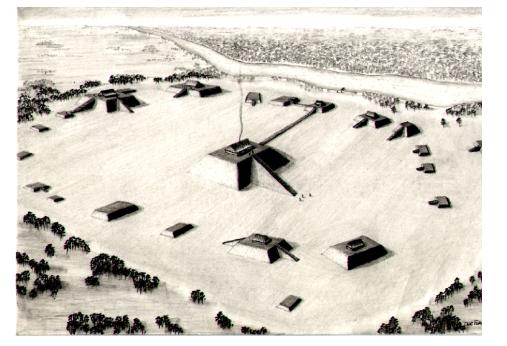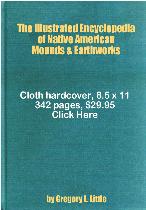 | ||
Above: Winterville, Mississippi mound complex reconstruction by Dee Turman. © 2009—reproduction on websites or by any other means strictly prohibited. | ||
ArchaeoTrek Citations from: The Illustrated Guide to Native American Mounds & Earthworks © 2009 by Dr. Greg Little Winterville, Mississippi • Mound Complex • Mississippian Mississippi State Park & Museum— located on State Hwy 1, about six miles north of Greenville, Mississippi. Courtesy of the Lower Mississippi Delta Region, National Park Service. We have previously reported on the amazing mound complex at Winterville, but it's so important that it should be mentioned again. It is a site few people visit, but one that will be remembered by those who make te trek. The Winterville site complex consists of flat-topped, rectangular ceremonial mounds of various sizes. The mounds are arranged around a 43-acre plaza, at the center of which is the 55-foot-high Mound A, the largest at the site. There are no extensive village remains, indicating that the site was occupied mainly during ceremonies. It is likely that only members of the social elite, such as chiefs, priests, and their retainers, were permanent residents of the site. Of the 23 mounds originally present, four were destroyed and several others reduced to remnants by agriculture and excessive grazing prior to the site's acquisition as a state park. Nevertheless, this mound group remains one of the largest and best-preserved in the southeastern United States with 12 mounds remaining. In recognition of its outstanding significance, the Winterville site has been designated a National Historic Landmark. Most of the mounds at the Winterville site were constructed during the Mississippian period, between 1200 and 1250 A.D. This intensive time of mound building reflects contact between local Indians of the Coles Creek Culture and influences emanating from the great Cahokia site in Illinois, the largest mound center in the United States. Archeological excavations were conducted at Winterville in 1967-1968. The finds included structural remains, burials, and many ceramic and stone artifacts. From this evidence, the history of the site was reconstructed. | ||
The Illustrated Encyclopedia of Native American Mounds & Earthworks — by Dr. Greg Little | ||
 | ||||
 | ||||